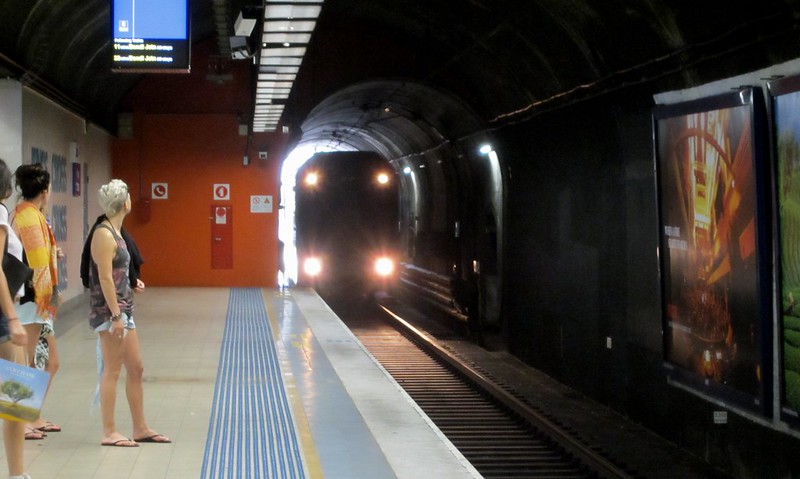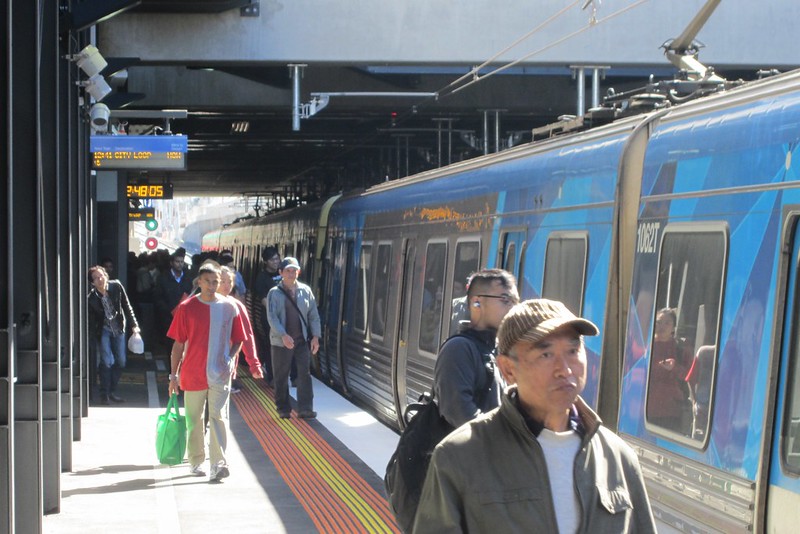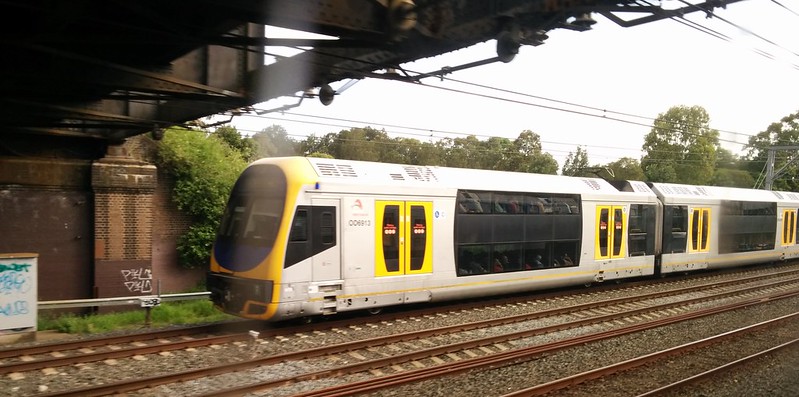It’s important to have a long-term plan. PTV has one for rail which is published here:
PTV Network Development Plan – Metropolitan Rail
— I’ve blogged about this plan when it was released.
Upgrades such as the Melbourne Metro Rail Tunnel and the new fleet of trains tie into this plan, and complement each other: the tunnel and its stations will be designed for the longer trains that the new fleet will deliver.
Here’s one snippet of information I had been asked about, and was wondering about, but was able to confirm with the project team recently: The metro rail tunnel will NOT be built to cater for double deck trains.
Obviously long tunnels are expensive. A decision has to be made about their size, and the smaller the better. In this case, they are not willing to invest the extra cost for provision for possible future double deck trains.
We’ve tried double deck trains before
The City Loop does cater for them. In the 70s when it was built, there were no definite plans for double deck trains (Hitachi trains were coming into service at the time), but they were considering it for the future.
A trial of a double deck train (the Federally funded “4D” — Double Deck Development and Demonstration Train) was done in the 1990s. Here it is in operation at Parliament:
It was modelled and based on Sydney’s double deck trains, but seemed to have continual reliability problems. It mainly ran on the Belgrave and Lilydale lines, but some other lines had the requisite bridge clearances. No doubt if a further rollout was planned, more bridges would have been modified.
Reliability aside, the authorities decided that such trains were not the way of the future. No more were built. The train was eventually sold to RailCorp NSW for spare parts, and scrapped in 2006.
The policy of staying single-deck is, when you look around, reasonably obvious: the recently rebuilt Springvale station doesn’t have a lot of space to spare above our current single deck trains.
(By the way, as I understand it, double stacked containers are not compatible with overhead wiring, so we won’t see them on our suburban tracks.)
There have been other Melbourne trials of new public transport vehicles. Marcus Wong has a great blog post about various tram types tested and rejected here. At least one test was successful: the initial B-class trams (2001 and 2002) in 1984-5 was followed by over 100 more brought into service in the late 80s and early 90s.
Is single deck or double deck better?
Arguments about this will rage forever I suspect, but there are pros and cons to each.
For a higher carrying capacity, single deck trains need to be longer, providing more doors, and theoretically faster loading and unloading. Faster loading means you can push more trains down the line, and helps counter some or all the capacity benefits of double deck.
Longer trains have an obvious cost: longer platforms and it may have other impacts such as on signalling and stabling. This is where Melbourne is going — the new fleet will start at 7 cars and extend to 9 or 10.
Double deck trains have higher capacity for the length — about 50% more. But they are obviously higher, meaning some existing tunnels and bridges need modification (which may or may not be practical) and extra cost when building new track, especially tunnels.
The power-to-weight ratio of the train could be an issue. Double deck trains obviously concentrate a lot more weight per carriage, while single deck trains that spread the load out over more carriages and wheel sets may assist good acceleration.
Some people will cite security issues, as the decks mean it’s not possible to look along the length of the train. Some also cite risks with level crossings, as the lower deck is vulnerable to a motor vehicle impact, though I’m not sure if that risk has been quantified.
Most cities have stuck with single deck for their high-capacity, short trip urban and metro networks, though the Paris RER is a prominent example of double deck high-capacity suburban operation, and they’ve designed double deck carriages with a third doorway, presumably at the cost of capacity. But I’m not sure any new lines or networks are being designed for double deck operation.
A number of European countries including Belgium, the Netherlands and Switzerland use them, but primarily for longer distances, where dwell times are less important.
NSW is moving to single deck for their new metro line. Meanwhile the UK is considering double deck for its commuter lines (eg NOT the Tube, which has tunnels that are very space-constrained).
No double deck for you!
The metro tunnel decision means for better or worse, Melbourne is sticking with single deck.
I don’t have a major problem with this.
It’d be nice to see the findings from the 90s trial out in public, but as long as the reasons for the decision have been thought through, carefully considered, and are understood, the focus can be on optimising the network for single deck operation.




18 replies on “The metro tunnel will cater for single deck trains only”
Yes, Daniel, like you, I’ve often wondered why we haven’t gone the same way as Sydney. Their double deckers seem to work OK (from a passenger point of view)
I think it’s important to note how double-deck are used on the RER. On RER A & RER E, the trains do have 3 sets of double doors 2m wide, with 2×2 seating on both levels to maximise capacity, This is because on RER A they ran out of track capacity, and the only solution was to go double deck, as well as 10 cars compared to the 8/9 car single deck trains operating. RER A and RER B also have single deck trains with 4 doors per side with 2×2 seating as well. RER C & RER D however are for longer journeys, and their 2×3 seating and narrower doors at either end of the carriage reflect this.
The 4D seems to be a little shorter than the waiting passengers’ expectations. I remember seeing it occasionally as it travelled over the Glenferrie Road railway bridge. I think Melbourne is set with single deck trains, and Sydney with double deck trains, except for the odd decision to make the new line incompatible with the rest of the system by only allowing for single deck trains.
I think it was a mistake for Sydney to go double deck.
Single deck service has about the same total capacity as double deck, allowing for slightly higher trains-per-hour capacity from shorter dwell time enabled by three-door cars. But with a smaller proportion of seats, obviously.
DD trains are better at maximising peak hour seats. They are worse at all other times: expensive, heavy, power hungry, and with a worse environment for passengers: lower ceilings, smaller windows, steps which are hostile to the elderly (who are an increasing proportion of the population), security concerns from not being able to see along the train (passive surveillance by others is very important for people’s sense of security at low use times).
Sydney’s DD train are typically full for two trips a day, and spend the rest of the day providing a costly and unattractive service with very low occupancy.
The people who are better off with DD service are the peak hour riders who get a seat in a DD train but would not in an SD train. The losers from DD service are everyone else. A back-of-the-envelope calculation suggest to me that about 5 per cent of riders are better off with DD trains. 95 per cent would be better off with SD trains.
If Sydney reverted to SD trains, obviously the loss to the losers (they don’t get a seat) would be greater than the gain to the gainers (the better environment of the SD car). You would want to do a proper cost benefit analysis to compare these. But the promoters of DD trains at least should admit that there are costs and benefits on both sides, and not just assume without argument that maximising peak hour seats is the only thing that matters.
What about wheelchair access.
Having double deck trains make it harder to fit more wheelchairs in I think.
Or even 1 wheelchair.
I wonder if double deck trains are worth considering for V/Line, where capacity per train is more important than dwell times.
V/Line has a much higher ‘commuter’ load than than Melbourne’s suburban network – a flood of workers flood into Melbourne each morning, and out again of an evening, with massive amounts of extra capacity outside these times. V/Line already has a fleet of older carriages with high density seating that are only used in peak times – so when the time comes to replace them. a fleet of double deck trains could be a cost effective way of handling the traffic, compared to buying more VLocity railcars.
@John, yeah it doesn’t really make sense for Sydney to convert existing DD lines to SD. I can kind of understand why they went with SD for the new line, though at the same time it seems a little short-sighted to cut it off from the rest of the network by not making the tunnels slightly bigger to accommodate DD. Perhaps there are aspects other than the tunnels themselves though; the new line is meant to be driverless operation, which perhaps makes it incompatible with the DD fleet anyway.
@Jacob, the area around the doors is at platform level. This includes space with seats and to accommodate wheelchair users, prams, and those who can’t climb stairs.
Given that only the Pakenham/Cranbourne lines plus the Sunbury line will feed into the metro tunnel, then that’s only a couple of corridors where they won’t be able to run DD trains.
I take it the 4D train only ran via the Burnley Loop corridors because the lines in question were the few lines where bridge/tunnels clearances etc were enough to cater for DD trains?
Based on this, would it be outside the realms of possibility that somewhere on either the electrified network (where the clearance is already there) and/or V/Line network, we could see a second attempt to introduce DD trains to Melbourne?
Sure they would be restricted to the existing city loop and lines that have the adequate clearance, but particular trains being confined to particular lines would be hardly anything new.
It sucks that the 4D train turned out to be a lemon, but one dud shouldn’t eliminate the possibility of future DD trains altogether, as someone pointed out, there would be some lines where the advantage of extra capacity would outweigh the disadvantage of longer dwell times.
You can run double-stack containers under overhead catenary, but the overhead needs to be at something like 6m.
Not really cost-effective to make such a major change to the loading gauge of the current Melbourne suburban network, but likely not so bad to implement if you’re electrifying (probably for electric freight locomotives) a current double-stack compatible line.
Hardly surprising, considering Melbourne is aiming to move towards a more metro-like network. I can’t think of one single double deck metro system in the world (and no, Sydney & Paris RER doesn’t count). So right decision I would say.
While I’m disappointed at the chance of a possible future upgrade, at the moment I’d rather see a higher frequency of trains than having trains that carry more.
A turn up and go model.
John’s comments are ridiculous. He thinks that Sydney’s double-deck trains have windows which are too small ? The batch made in 1965 with small windows on the upper deck were all phased out about 15 years ago, so he hasn’t been on one, lately . And the ceiling’s a bit low ? Oh dear ! Let’s all stand for 70 minutes, twice a day, in cattle-car conditions, to satisfy John’s concerns about the inadequate height of the ceilings.
The question of “overcapacity” of off-peak trains is an interesting one. They used to run four-car trains during the interpeak and evenings and weekends in Sydney. Doing so would reduce power consumption, and also wear and tear on the rolling stock, and also increase passenger density if this is perceived to be a security benefit ( of which I am dubious, but anyhow… ). They stopped doing this, purely as a union-busting exercise, to get rid of the guys whose jobs it was to couple and uncouple the trains. The latest batch of Sydney trains are no longer capable of being divided in half, but the older batches are still about 70% of the fleet so they could do this, if they wanted to. Meanwhile, on the weekend, they run 4-car trains on the central coast line, which results in passengers standing for 90 minutes.
Enno: ‘Let’s all stand for 70 minutes, twice a day, in cattle-car conditions…’
If Sydney reverted to single-deck trains then, as I said, there would be winners and losers, and you would want to do a proper analysis of the benefits and costs. My calculation is that the losers would be about 5 per cent of total trips [note 1]
My main point is that it’s wrong to assume that the people who are better off with DD trains are the only people who matter. DD trains are unfriendly to the elderly, who are an increasing proportion of the population, and they are particularly unfriendly to less confident riders at low use times. The security concern is not trivial. I am an adult male lifelong confident transit user, but even I don’t like entering the upper or lower deck of an almost empty DD car without being able to see who’s in it already.
The potential riders who are discouraged from using the trains by the DD cars are not so visible, but we shouldn’t forget them.
For many years Sydney’s train service has been optimised to maximise peak period seats to the central area at the expense of providing relatively infrequent and unattractive offpeak services. This has contributed to the extreme peakiness of Sydney train use and the very poor farebox cost recovery (since handling extra peak trips has a high marginal cost). In a future with more peak spreading and more diverse travel patterns (in time and space), it will be more important to optimise the service for any time, any place travel. Running a frequent, all day service of economical single-deck trains would be an important part of that.
In any case, I argue that with a single deck conversion peak direction seats could be maintained at about the present level by various workarounds: more intensive use of the lines that now have spare capacity (Illawarra and Inner West), and running some peak extra double deck trains from the outer west to Sydney Terminal on the main western line, which has spare capacity. [note 2]
For you Melbourne folks, this is a longwinded way of saying I think Melbourne was right not to go double deck.
Note 1. In fact the losers, considered as individual people, not trips, would be less than this, since the loser trips would be mostly by regular daily commuters, while the winner trips would be made by a larger number of less regular offpeak riders.
Note 2: These could be 12 car trains, as proposed in a government report a few years ago. Half a dozen peak hour extra 12 car DD trains to Sydney terminal would more than make up for the reduction in seats from converting the Parramatta-North Sydney line to single deck.
I grew up living on the Belgrave line for the first 28 years of my life and can remember riding on the 4DD train as a child, and later on travelling home from school (we used to finish an hour early on a Friday and I caught it and changed at Ringwood for my Belgrave one). Whilst at that age, there was a definite novelty and I typically enjoyed catching it – looking back on it I can see how it wasn’t all it was cracked up to be. The train HAD to wait for around 30
minutesseconds at EVERY station, including stations not even 1 km from the next, such as East Camberwell, Camberwell, Auburn and Glenferrie. This 30 second dwell time includes stations such as Tecoma, which typically has very few passengers getting on or off. Indeed, the Hitachi and Comeng trains which were typical of the trains used in that era, would normally stop at Tecoma for no more than 10 seconds. This extra 20 seconds per station, adds a whole 9 minutes to a stopping all stations, train journey from Flinders street direct to Belgrave.This blog links to your review of the 2013 Network Development Plan for Rail. You mentioned in your review that a Bus and Tram plan was coming – have we seen it yet?
@Harry, no, still not released. The Train Development plan is here: https://www.ptv.vic.gov.au/about-ptv/ptv-data-and-reports/